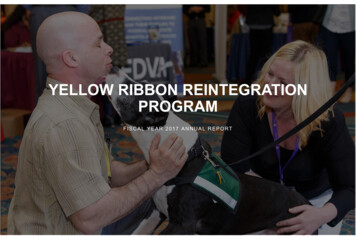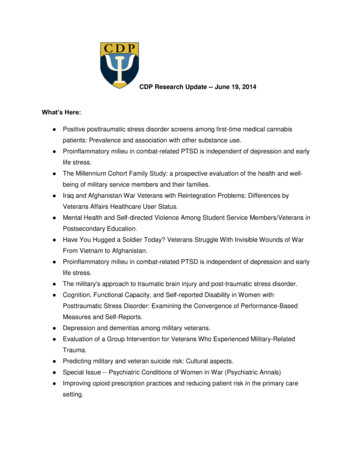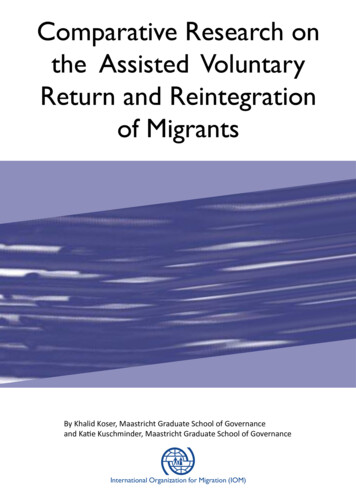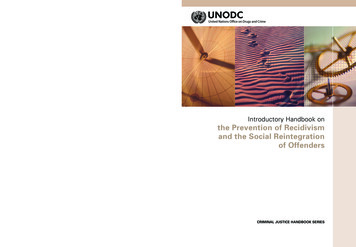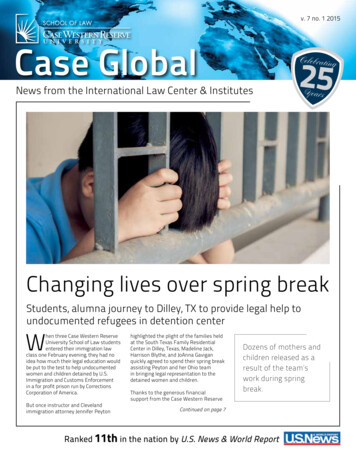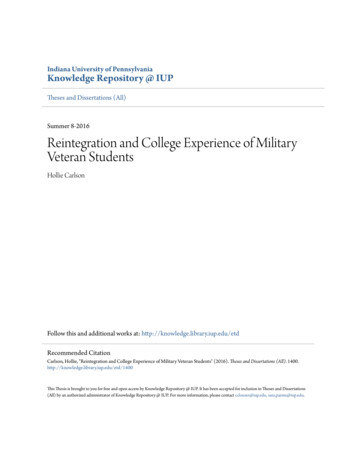
Transcription
Indiana University of PennsylvaniaKnowledge Repository @ IUPTheses and Dissertations (All)Summer 8-2016Reintegration and College Experience of MilitaryVeteran StudentsHollie CarlsonFollow this and additional works at: http://knowledge.library.iup.edu/etdRecommended CitationCarlson, Hollie, "Reintegration and College Experience of Military Veteran Students" (2016). Theses and Dissertations (All). 1400.http://knowledge.library.iup.edu/etd/1400This Thesis is brought to you for free and open access by Knowledge Repository @ IUP. It has been accepted for inclusion in Theses and Dissertations(All) by an authorized administrator of Knowledge Repository @ IUP. For more information, please contact cclouser@iup.edu, sara.parme@iup.edu.
REINTEGRATION AND COLLEGE EXPERIENCE OF MILITARYVETERAN STUDENTSA ThesisSubmitted to the School of Graduate Studies and Researchin Partial Fulfillment of theRequirements for the DegreeMaster of EducationHollie CarlsonIndiana University of PennsylvaniaAugust 2016
Indiana University of PennsylvaniaSchool of Graduate Studies and ResearchDepartment of Kinesiology, Health, and Sport ScienceWe hereby approve the thesis ofHollie CarlsonCandidate for the degree of Master of EducationDavid Wachob, D,Ed.Assistant Professor of Kinesiology, Health, andSport Science, ChairDavid Lorenzi, Ed.D.Assistant Professor of Kinesiology, Health, andSport ScienceKeri Kulik, Ph.D.Assistant Professor of Kinesiology, Health, andSport ScienceACCEPTEDRandy L. Martin, Ph.D.DeanSchool of Graduate Studies and Researchii
Title: Reintegration and College Experience of Military Veteran StudentsAuthor: Hollie CarlsonThesis Chair: Dr. David WachobThesis Committee Members: Dr. David LorenziDr. Keri KulikThe purpose of this study is to quantify the number of undergraduate and graduateveteran students at Indiana University of Pennsylvania who have suffered experience to stressfulevents in the military, and are now reintegrating back into civilian life as a college student. Asurvey was electronically dispersed to undergraduate and graduate students, examining if theyfelt their time in the military affects their academic experience, if they struggle to fit in oncampus, and if felt uncomfortable on campus because of unpleasant experiences from themilitary. The most significant finding after analysis of the surveys, was the correlation betweenmilitary experience and college experience. The student veterans who reported having fewertraumatic military experiences, more commonly reported having a more positive collegeexperience.iii
TABLE OF CONTENTSChapter1PageINTRODUCTION .1Statement of the Problem .1Research Question .2Hypotheses .3Significance of the Study .3Assumptions.4Limitations .4Definition of Terms.42REVIEW OF LITERATURE .5Military Stressors .5PTSD in the Military.6Returning Veterans .7Veterans on Campus .73METHODOLOGY .9Introduction .9Study Sample .10Data Collection .10Instrument .11Data Analysis .114RESULTS .13Participants .13Student Veteran Struggle to Fit in on Campus .16Impact of Military Time on Academic Experience .18Student Veteran’s Feelings on Campus Because ofUnpleasant Experiences From The Military .205SUMMARY, CONCLUSIONS, RECOMMENDATIONS .24Summary .24Conclusions .25Research Question 1 .25Research Questions 2 .26iv
ChapterPageResearch Question 3 .26Recommendations .28Recommendations for Colleges Working with Veterans .28REFERENCES .30APPENDICES .38Appendix A – Site Approval Form .38Appendix B – Participant Informational Email .39Appendix C – Veteran College Student Survey Questionnaire .40v
LIST OF TABLESTablePage1Demographic Statistics of the Participants .142Military Statistics of the Participants .153Military Experience of the Participants .164College Experience Scale .175Male and Female College Experience .176Grade Point Average and College Experience.187Service and Grade Point Average .208Military Experience Scale .219Overall Military Experience .2210Military and College Experience Correlation .22vi
CHAPTER 1INTRODUCTIONStatement of ProblemPost-Traumatic Stress Disorder (PTSD) is a relatively newer research topic and isgrowing in the literature though it wasn’t introduced into the formal diagnostic lexicon until1980 (Wise, 2015). PTSD is a condition experienced after a traumatic life event and is often longterm and painful to endure (Vinokur, 2011). PTSD is a disorder brought on after experiencing atraumatic event. During a traumatic event, one thinks that their life or others' lives are in danger.They may feel afraid or feel that they have no control over what is happening around them.If their reactions don't go away over time and they disrupt their life, they may be experiencingPTSD (PTSD, 2015). With the increased rates of PTSD studies have been conducted to showhow much specific areas of life are impacted. One study reported that individuals with posttraumatic stress disorder have a significantly lower employability rate than those who sufferfrom PTSD which translates into significantly poorer return-to-work rates (Matthews, 2006).Those military members returning home are experiencing posttraumatic stress disorderand other mental health issues at rates that haven’t been seen since the Vietnam War (Garske,2011). According to the Congressional Research Service, the number of military membersdiagnosed with PTSD grew by 1,611 people in the year 2000(Fischer, 2014). In 2010, thatnumber increased to 3,139 military members being diagnosed with PTSD that year (Fischer,2014). In total from the year 2000 – 2013, 34,157 members who had not previously beendeployed had were diagnosed with PTSD and 118,829 members diagnosed who had previousdeployments (Fischer, 2014).1
Individuals with PTSD, particularly veterans, show signs of cognitive impairment whentested with neuropsychological instruments, more so than individuals exposed to trauma who donot have PTSD (Qureshi, 2011). Stress is also known to have an effects on functions of newlearning and memory that are mediated by the hippocampus, which can be damaged by atraumatic or stressful event (Bremner, 1999). With the rise in PTSD prevalence, and militarymembers returning to academics and occupational settings, accommodations needed to be made.This increased presence of veterans on college campuses has left some institutions illprepared in providing resources to these students. One study examining veterans on collegecampuses suggest that combat veterans are a student population with special needs and requiresupport from both policymakers and program providers (Ackerman, 2009). An important meansof building inclusive communities on campuses is to provide services that support the needs ofunique groups of students. Student affairs programs provide services that assist special studentpopulations (DiRamio, 2008).With such a large population of individuals being diagnosed with PTSD, and a number ofthe population who has experienced a traumatic stressful event being unaccounted for, it hasbecome increasingly relevant to understand what some of the struggles are that this population isexperiencing. Without an understanding of what these difficulties might be, steps cannot betaken to make reintegration into professional or academic setting happen with more ease.Research Questions1.Do student veterans struggle to fit in on campus?2.Do student veterans feel their time in the military affects their academic experience asdefined in part by GPA?2
3.Do student veterans feel uncomfortable on campus because of unpleasant experiencesfrom the military?Hypotheses1.Student veterans reintegrating onto college campuses will experience different difficultiesfitting in on campus.2.Academic experiences will be negatively affected based on the student veteran’s timespent in the military.3.Levels of comfort on campus for the student veterans will be negatively influenced byunpleasant military experiences.Significance of the StudyThere have been studies conducted on what struggles an individual may encounter whentrying to reintegrate back into the work and academic lifestyle after being exposed to a traumaticstressful event (DiRamio, 2008). However, there is little research looking at how militaryexperience might influence a veteran’s ability to reintegrate and obtain academic or occupationalachievement. This study is being conducted to investigate the struggles veteran students arefaced with during their period of reintegration into academia on a college campus. Reintegrationafter a traumatic stressful event is a serious challenge that hasn’t been examined until recently.The men and women who suffer from these events have been researched in many personal andsocial ways, but extensive research into the affects it has had in their professional and academiclife at IUP has never been done. While analyzing results, it will be determined what some of thespecific struggles are for an individual after suffering from a traumatic stressful event whenattempting to reintegrate into the occupational and academic fields. This study also examines ifthese student veterans utilize campus-funded support for veterans and if they feel supported as a3
veteran. If this research shows there is a high impact of traumatic stressful events on the abilityto succeed academically, measures can start being taken to better prepare and provide theseindividuals with the appropriate resources.AssumptionsThe following assumptions guided this study:1.All participants have had a traumatic stressful event and experience with reintegrationonto a college campus.2.The participants complete the surveys accurately and to the best of their ability.LimitationsThe following limitations guided this study:1.A small sample of research participants will be available to participate in this study.2.The research will rely on the participant’s ability to accurately recall information neededfor the survey.Definition of TermsReintegration – “The U.S. Department of Defense (DoD) does not offer a uniform definition ofreintegration, but these programs typically emphasize certain areas, including finding purpose inlife; inter personal relationships; employment or schooling; and access to benefits, housing, andhealth care” (DoD, 2011; Uniformed Services University of the Health Sciences, 2004).Post-Traumatic Stress Disorder - PTSD is a condition experienced after a traumatic life eventand is often long term and painful to endure (Vinokur, 2011).4
CHAPTER 2REVIEW OF LITERATUREMilitary StressorsResearchers are beginning to examine the significance of what may be happening in thelives of those who have experienced a traumatic stressful life event and the struggles they may beencountering during their period of reintegration. It is important to note the significance placedon the struggles student veterans have such as” problems with cognitive skills, judgment,concentration/memory, difficulty coping under pressure, difficulty interacting with others,responding appropriately to social cues, problems with authority, problems with constructivefeedback, and unpredictable absences” (Church, 2009). To face these potential barriers thestudents need to first recognize that they may be struggling during reintegration.When looking at traumatic stressful events it is important to note that in the case of theveteran participants, the stressor will most commonly come from a military experience.However, the stressors that are experienced in the military setting have similarities such as beingin a violent relationship (Campbell, 2002) or living in a dangerous neighborhood (Ross &Mirowsky, 2001). Exposure to a harsh physical condition or fear of a near death experience issomething that civilians may experience a handful of time, but veterans often experience this sortof elevated fear for months at a time (Basham, 2008). After returning to an academic setting,specifically that of a full time, on campus student, finding means of helpful reintegration is acrucial part of the veteran student’s success. There is currently no national-level systematic effortin higher education to assist student veterans, but there is research finding that connecting withother veterans on campus helps student veterans’ transition to college life (DiRamio et al, 2008).5
The nature of being in the military often requires an individual to be exposed to what maybe a stressful event on multiple occasions. Individuals with a trauma history rarely experienceonly a single traumatic event but rather are likely to have experienced several episodes oftraumatic exposure (Kessler,2000). The number of veterans coming back with a neurological orpsychological disorder such as PTSD continues to grow. Given that most estimates put thelifetime prevalence of PTSD between 9% and 31% for those expose to combat (Card, 1987;Centers for Disease Control, 1988; Kulka, 1990; Southwick, Morgan, 1993), over 500,000veterans in this country alone may suffer from PTSD symptomatology.PTSD in the MilitaryCompared to people without a trauma history, trauma survivors are at a higher risk formultiple problem including depression, substance abuse, suicidal and homicidal behavior,physical illness, and poverty (Burnman et al., 1988; Byrne, Resnick, Kilpatrick, Best, &Saunders, 1999; Keane & Wolfe, 1990; Kessler et al., 1995; Schnurr, Spiro, Aldwin, & Stukel,1998). Those individuals who are members of the military are exposed to many risk factors thatincrease their odds of suffering from psychological disorders such as PTSD including long termexposure to stressful events and the threat of returning to the stressful event (Rona, 2012). Theincreased exposure to traumatic stressful events increases the probability of these individualsdeveloping PTSD and suffering from long term side effects (Rona, 2012). PTSD in the militaryis caused by being exposed to stressful events, but is also caused by the emotional responsesfollowed by those events such as guilt and blame (Wessely, 2005).PTSD may not develop until the military servicemen and women have returned homefrom their service. Due to the delay in symptoms, the individual might experience troublerecognizing that they are struggling with a serious psychological disorder (U.S. Department of6
Veterans Affairs). The delay in recognition can cause an individual to have the inability torecognize .they are having trouble with symptoms of the disorder, such as concentration, makingwork and especially an academic career increasingly difficult (Sayer, 2009).Returning Veterans“Educational benefits was the most commonly cited reason for joining the military in thebeginning of the Global War on Terror” (GWT; U.S. General Accounting Office, 2001). “Formany of the 2.3 million veterans returning from the conflicts in Afghanistan and Iraq, going tocollege has been a popular method of reintegration (Iraq and Afghanistan Veterans of America”,2010). Individuals have different experiences with reintegration in regards to various scenarios.A study done focusing on reintegration problems for Iraq and Afghanistan war veteransstated that half of their participants reported perceived problems during reintegration (Sayor,2014). These issues range from a variety of emotional disorders, mental disorders and physicaldisorders. One of the more serious physical injuries reported on the rise is Traumatic BrainInjuries, or TBI. Studies also report based on surveys of individuals formerly deployed toAfghanistan and Iraq suggest that 10–23 % may have had a deployment-related TBI (Sayer et al.2014). All aspects of each veterans health needs to be considered during their time ofreintegration.Veterans on CampusAlthough every individual reacts to a trauma in a unique way, there are similarities foundin those individuals who suffer from PTSD. Symptoms as listed on the PTSD Checklist-Militaryversion or, PCL-M range in severity from mild symptoms, only interfering in daily life in smallways, to very severe symptoms that are invasive to an individual’s everyday life (Weathers,2013). When veteran students return to the classroom, there is no way to predict how they are7
going to be able to adapt and react to being in that setting again and if the classroom is preparedto effectively teach a returning veteran (Zinger, 2010).These kind of issues quickly become troublesome for an individual who is reintegratingback into academia. After a traumatic stressful event, one often experiences periods ofrestlessness and frequents bouts of anxiety (Weather, 2013, Zinger, 2010). Having this type ofconstant mentality makes it increasingly difficult for a student veteran to actively andsuccessfully participate in academics while maintaining a functional quality of life. Whenreturning to a college campus, having a support system in place, or a plan for these students iscrucial in their success (Ackerman, 2009). Accommodations for PTSD symptoms such asfrequent absences, longer time needed for testing or assignments, and an advocate whounderstand their situation, are all key elements to helping these students be success inreintegrating into the environment as successfully as possible (Ackerman, 2009).Another issue these student veterans face is feeling a constant disconnect. Not only isdisconnection a symptom of PTSD, but there is also a preconceived disconnection with veteransand most college students because of their experiences and age difference (Elliott, 2011). Thiselement adds another layer of feeling like nobody is there to understand what the student is goingthrough. Finding these connections can foster a feeling of comfort that can keep these studentsgrounded and give them the security needed to seek out helpful resources. The feeling ofalienation can add another layer to an individual’s symptoms that will compile into the diagnosisof PTSD (Elliott, 2011).8
CHAPTER 3METHODOLOGYIntroductionParticipants for this study were recruited through the Military Resource Office at IndianaUniversity of Pennsylvania’s main campus. The Military Resource Center is focused onproviding support to veteran students returning to academics at IUP. The office works with otheroffices on campus to ensure the students have a place to go as a contact for any issues they mayencounter. The focus for the office is to ensure the fostering of academic success for thereturning veteran students. Eligible participants received study information through their IUPemail account.This survey will attempt to answer these three research question:1.Do student veterans struggle to fit in on campus?2.Do student veterans feel their time in the military affects their academic experience asdefined in pare by GPA?3.Do student veterans feel uncomfortable on campus because of unpleasant experiencesfrom the military?This survey was sent with the following hypothesis in mind:1.Student veterans reintegrating onto college campuses will experience different difficultiesfitting in on campus.2.Academic experiences will be negatively affected based on the student veteran’s timespent in the military.3.Levels of comfort on campus for the student veterans will be negatively influenced byunpleasant military experiences.9
Study SampleThis study includes all students who are identified as military veterans attending IndianaUniversity of Pennsylvania. Both undergraduate and graduate students who served in any branchof the military and are identified as veterans will be eligible to participate. Both male and femalestudent veterans will be invited to participate in this study. The survey was sent to approximately240 undergraduate and graduate student veterans at Indiana University of Pennsylvania, the totalnumber of veteran students on campus.Data CollectionData was collected using a combination of two separate survey instruments. Eligibleparticipants received an email asking them to participate in this study. Contact with participantswas made solely through the IUP Military Resource Center, sent through the appropriate veteranemail list serve and was unavailable to the researcher. Keeping contact through the MilitaryResource Center ensures complete anonymity for this group of students. Site Approval wasgranted from the Military Resource Center and reference in Appendix A.All information about the study was summarized into a brief informational email,referenced in appendix B. This cover page outlined the nature of the study, the participant’s rolein the study, potential benefits and risks of participation as well as instructions and consentprocedures. The participants were asked to complete the survey that was modified into emailformat through a third party website known as Qualtrics. Student veterans who agreed toparticipate opened the link through their email that took them to the survey on the Qualtricswebsite. At that time, participants who completed the survey were eligible to be entered in adrawing for a 50 gift card to the Co-Op store at IUP.10
InstrumentThe survey instrument utilized for this study combines The PTSD Checklist VeteranVersion (PCL-M) (Weathers, 2013) and the Survey of Student Veterans (Elliott, 2011).The PTSD Checklist Veteran Version (PCL-M) is a 17 item scale used for individuals to selfreport on PTSD symptoms. This instrument is used as a screening tool for individuals who mayhave PTSD. It is used to evaluate the symptoms of PTSD and monitor how the individual is atany given time or how the individual is progressing. The checklist can be administered at anytime to evaluate and aid in diagnosis of PTSD.The Survey of Student Veterans was developed by Dr. Marta Elliott (Elliott, 2011) as aninstrument to measure several aspects of an individual’s experience during reintegrating intoacademics. This survey will evaluate the level of comfort and support an individual feels duringtheir time of reintegration from military to academic lifestyle. The survey can be referenced inAppendix C. The investigation into reintegration goes past the surface of just academics andexamines the veteran student’s personal, and professional lives as well as demonstrated in thesurvey.Data AnalysisThe survey was administered electronically using a product called Qualtrics, an onlinesurvey software program that allows researchers to develop and administer web-based surveys(Phillips, Guss, & McGarry, 2011). The program provided a private link to the questionnairethat participants accessed through their email accounts. Lastly, the Qualtrics software assisted inanalyzing questionnaire results for statistical information related to the study research questions.Participants were only permitted to complete the survey one time, which was automatically11
monitored through the Qualtric software. The survey results were analyzed using SPSS(Statistical Package for the Social Sciences) software (Levesque, 2007).To answer the research questions developed for this study, several tests will be conducted toprocess the results. For instance descriptive statistics will be used to describe the demographicinformation. Independent t-tests will be used to compare the self-reported symptoms of PTSD(PCL-Checklist) with the Survey of Student Veterans report. Any differences between gender (ttest) and age (ANOVA) will also be determined.12
CHAPTER 4RESULTSParticipantsThe data from this study was collected from student veterans at Indiana University ofPennsylvania. All student veterans who participated in this study served in one or more branchesof the United States military and returned as students at the collegiate level at IUP. Theparticipants were student veterans at both the undergraduate and graduate level. The survey wassent out electronically through email using Qualtrics. The electronic survey was sent out for twoweeks with a reminder email sent after one week.Of the 240 students who received the survey, a total of 18 students (7.5%) completed thesurvey. Due to the limitation of the survey be sent through a third party as well as the studentsreceiving the survey during the final week of the semester, a low response rate was expected.The survey was sent out initially and again with a follow up reminder one week later. During thestudy, there was a dropout rate of about 30% when students were asked about seekingcounseling, leaving 11 participants to fully complete the survey. Of the seven individuals whodropped out of the survey, all seven withdrew from the survey after the same question. Thoseindividuals voluntarily withdrew from the survey after being asked if they had ever sought orreceived counseling related to their military experience. All individuals responded to theprevious question but when asked why they did not seek counseling, those seven participantswithdrew from the survey. Students were encouraged to withdraw from the study anytime theybecome uncomfortable. All students met the participation qualifications as the survey was onlysent to student veterans. Of the 18 initial participants 16 of the participants were male and two13
were female as shown in Table 1. Table 1 also displays the race, time spent in college, collegerank, and grade point average of each participant.Table 1Demographic Statistics of the ParticipantsGenderRace/EthnicityYears in CollegeEducation LevelGrade Point te1689.9African American211.1Less than 1316.71-2211.13-4422.2More than 11.12.0-2.49316.7Under 2.00--Of the 18 participants, 16 of those participants were Caucasian while two participantswere African American. Eight of the participants, making up about 50% were graduate studentswhile the remaining ten students were undergraduate students. The average age of theparticipants was 29 years of age.Table 2 displays the military statistics for the participants. This table outlines what branchof military the participant served in, if they ever completed an overseas tour, if they have14
received any type of veteran benefit, what type of benefits they have received and how much oftheir expenses are covered by veteran benefits. Table 2 displays how frequently and whatpercentage of participants selected each response.Table 2Military Statistics of the ParticipantsBranch of the MilitaryTours of DutyVeteran BenefitsCollege Expenses Covered by BenefitsType of BenefitsFrequencyPercentageArmyAir ForceNavyMarine CorpsCoast 4No15.6None211.1About 25%0--About 50%316.7About 75%633.3100%738.9Tuition Assistance TopUp316.7G.I. Bill Benefits18100Disability Benefit
This Thesis is brought to you for free and open access by Knowledge Repository @ IUP. It has been accepted for inclusion in Theses and Dissertations (All) by an authorized administrator of Knowledge Repository @ IUP. For more information, please contactcclouser@iup.edu, sara.parme@iup.edu. Recommended Citation

